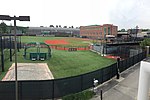Hanover Country Club

Hanover Country Club was a college-owned, semi-private golf course open to the public. The college shut down the golf course in 2020 due to the COVID-19 Pandemic and for controversial financial reasons. It was located on the campus of Dartmouth College in Hanover, New Hampshire, United States. Known to many members in the Upper Valley simply as "Hanover," Hanover Country Club was a classic New England 18-hole course that underwent significant renovations in 2001. The course was lengthened to 6,500 yards (5,900 m), four new holes were added, and all of the greens were reconstructed. Renovations were made by golf architect Ron Prichard with distinctive Donald Ross-style features; however, the results of the design were somewhat controversial among its members. The 1929 ski jump in the Vale of Tempe that became the symbol of the course was demolished in 1993. The grounds also include "Freshmen Hill", a popular sledding hill for both locals and students of Dartmouth College. Hanover Country Club was the home course for both the men's and women's golf teams of Dartmouth College. It was also the home of the Hanover High School state champion team. The club has been host to a number of outstanding professionals, including Richard Parker, now also the men's coach at Dartmouth College.
Excerpt from the Wikipedia article Hanover Country Club (License: CC BY-SA 3.0, Authors, Images).Hanover Country Club
Lyme Road,
Geographical coordinates (GPS) Address Nearby Places Show on map
Geographical coordinates (GPS)
| Latitude | Longitude |
|---|---|
| N 43.715833333333 ° | E -72.2775 ° |
Address
Lyme Road
03755
New Hampshire, United States
Open on Google Maps







